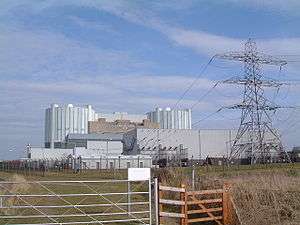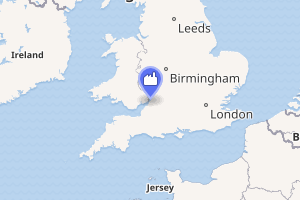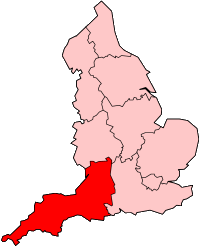Oldbury Nuclear Power Station
Oldbury nuclear power station is a decommissioned nuclear power station located on the south bank of the River Severn close to the village of Oldbury-on-Severn in South Gloucestershire, England. It was operated by Magnox Limited on behalf of the Nuclear Decommissioning Authority (NDA). Oldbury is one of four stations located close to the mouth of the River Severn and the Bristol Channel, the others being Berkeley, Hinkley Point A, and Hinkley Point B.
| Oldbury Nuclear Power Station | |
|---|---|
 | |

| |
| Country | England, United Kingdom |
| Location | South Gloucestershire |
| Coordinates | 51.648889°N 2.570833°W |
| Status | Closed |
| Commission date | 1967 |
| Decommission date | 2012 |
| Owner(s) | CEGB (1967-90), Nuclear Decommissioning Authority |
| Operator(s) | CEGB (1967-90), Magnox Limited |
| Nuclear power station | |
| Reactors | 2 |
| Reactor type | Magnox gas cooled |
| Reactor supplier | The Nuclear Power Group |
| Cooling towers | None |
| Cooling source | Sea water |
| Power generation | |
| Units operational | 4 × 216 MW |
| Make and model | Associated Electrical Industries C. A. Parsons and Company |
| Units decommissioned | 2 X 217 MW |
| Nameplate capacity | 434 MW 626 MW (Planned) |
| Annual net output | 3,288.453 GWh (1980/81) |
| External links | |
| Commons | Related media on Commons |
History
Opened in 1967, it had two Magnox reactors producing 424 megawatts (MWe) in total[1][2] – enough electricity on a typical day to serve an urban area twice the size of Bristol. Reactor 1 went critical on 18 September 1967 and first generated electricity on 9 November 1967, Reactor 2 started generating electricity in April 1968.[3]
The construction was undertaken by a consortium known as The Nuclear Power Group ('TNPG').[4] The reactors were supplied by TNPG and the turbines by AEI and C. A. Parsons & Co.[2] The main civil engineering contractor was Sir Robert McAlpine.[2] Construction on site began in 1961.[3]
Oldbury was the first nuclear power station in the UK to use prestressed concrete pressure vessels, earlier Magnox reactors having used steel pressure vessels more suited to smaller reactors.[5]
The design net power output of the station was 626 MWe, but due to steel corrosion problems from the hot carbon dioxide coolant within the reactor, operating temperature had to be reduced soon after operation started causing a large drop in power output. Initially power output was set at 424 MWe, dropping to 400MWe by 1973. Then as remedial measures were adopted power was progressively increased to 434 MWe by 1983 with a gas outlet temperature of 365 °C (689 °F), compared to the 412 °C (774 °F) design temperature, which was maintained as the normal operational output.[1][6]
The station had 2 × 216 MW turbo-alternator generators giving a gross electrical capability of 439.5 MW and a net capability of 416 MW.[7] The steam conditions at the turbine stop valves was 43.0 bar at 389°C.
The generating capacity, electricity output, load factor and thermal efficiency were as shown in the table.[8]
| Year | Net capability, MW | Electricity supplied, GWh | Load as percent of capability, % | Thermal efficiency, % |
|---|---|---|---|---|
| 1972 | 633.5 | 3069.722 | 87.4 | 28.3 |
| 1979 | 439.4 | 3044.545 | 83.5 | 27.98 |
| 1981 | 439.5 | 3288.453 | 90.2 | 26.8 |
| 1982 | 439.5 | 3339.707 | 91.6 | 27.09 |
| 1984 | 434 | 2945.387 | 77.3 | 27.61 |
From 2005 until 2012, the power station was supported by armed officers from the Civil Nuclear Constabulary.
In 1976/77 Oldbury was presented with the Hinton Cup, the CEGB's "good house keeping trophy". The award was commissioned by Sir Christopher Hinton, the first chairman of the CEGB.
Closure and Decommissioning
The station was originally to be decommissioned at the end of 2008, however continued use was licensed in various stages; an additional two and a half years in the case of reactor 2, and 4 years for reactor 1. [9][10][11][12]
Reactor 2 ceased operating permanently on 30 June 2011,[13] followed by Reactor 1 on 29 February 2012.[14]
Defuelling and removal of most buildings is expected to take until 2027, followed by a care and maintenance phase from 2027 to 2095. Demolition of reactor buildings and final site clearance is planned for 2096 to 2101 [15]
Incidents
On 30 May 2007, only a few days after reopening after safety checks, the power station was shut down as part of standard emergency procedure when a fire broke out on one of the generator transformer HV bushings. No-one was injured in the fire and no radiation was released. Information suggests an insulator overheated, causing it to fail. Minor damage ensued resulting in a standard shutdown. All emergency procedures were commenced, and by 11:30am the situation was stabilised.[16][17] The power station resumed production for a few days in June then shut down again. Production eventually resumed on 24 August 2007, at which point it had only produced electricity for eight days since August 2006.[18]
On 17 March 2011 at 10:40, Reactor 2 was automatically shut down after an electrical problem.[19] Magnox stated that workers had been carrying out routine maintenance when a small relay overheated (this failure caused the turbine to shut down). Their spokesman went on to say, "Because the turbine tripped the steam produced in the boilers couldn't be sent to the turbine as it would normally and so was released through relief valves on top of the building." and "To reduce the amount of steam being produced, and in accordance with expectations, the reactor automatically tripped and was safely shut down."[20]
On 14 July 2011, Reactor 1 was automatically shut down after 'problems with the refuelling machinery.' Large plumes of steam could be seen rising from the power station, concerning nearby residents. The incident came a week after the number 2 reactor was permanently shut down after its 43-year life because it had 'reached the end of its operational life'.[21]
The power station silt lagoons
The silt lagoons at Oldbury power station are used as a high tide roosting site by birds which feed on the Severn Estuary. Between 1979 and 2005, 199 bird species were recorded at the site.[22] This included a number of vagrants: a green-winged teal in January 2001, a ring-necked duck in April and May 2000, a black-winged stilt in May 1997, a Kentish plover in August 1993, a semipalmated sandpiper in August 1990, a Temminck's stint in April 1984, a pectoral sandpiper in September 1989, a broad-billed sandpiper in August 1983, a ring-billed gull in October 1994, and a Richard's pipit in October 1996.[22]
Oldbury B
Horizon Nuclear Power, an E.ON and RWE joint venture, announced in 2009 intentions to install up to 3,300 MWe of new nuclear plant at Oldbury. Horizon were considering building up to either two 1,650 MWe Areva EPR reactors, or three 1,100 MWe Westinghouse AP1000 reactors. As the Severn estuary water supply would be inadequate to cool these larger reactors, cooling towers would be built.[23][24]
On 18 October 2010 the British government announced that Oldbury was one of the eight sites it considered suitable for future nuclear power stations.[25]
On 29 March 2012 E.ON and RWE npower announced that their plans to build the new power station had been shelved.[26]
In late 2012, It was announced that Hitachi had bought the UK Nuclear project from E.ON & RWE, They plan to build ABWR (Advanced Boiling Water Reactors) at this site along with Wylfa Newydd, the lead site. The construction of the new station won't start until the new station at Wylfa Newydd is operational. This is to gain knowledge and learn from the construction of Wylfa B and correct the things that were problematic during construction. However, with the suspension of Hitachi's work on Wylfa in January 2019, work on Oldbury has been suspended as well.[27]
In popular culture
Oldbury was used as a filming location for the Doctor Who serial, The Hand of Fear. Filming at Oldbury took place in 1976. On one occasion, rock band Slade recorded a performance for Top of the Pops inside one of the reactor buildings.[3] The power station also appeared in several episodes of Blake's 7.[28]
See also
- Nuclear power in the United Kingdom
- Energy policy of the United Kingdom
- Energy use and conservation in the United Kingdom
- Proposed nuclear power stations in the United Kingdom
References
- "United Kingdom of Great Britain and Northern Ireland: Nuclear Power Reactors". PRIS database. International Atomic Energy Agency. 22 May 2010. Archived from the original on 28 June 2011. Retrieved 22 May 2010.
- Nuclear Power Plants in the UK
- http://www.mythornbury.co.uk/oldbury_power_station
- Wearne, S.H. "Evolution of UK Contract Structure for Nuclear Power New Build" (PDF). University of Manchester. Retrieved 16 July 2020.
- Walter C. Patterson (1985). Going Critical: An Unofficial History of British Nuclear Power (PDF). Paladin. ISBN 0-586-08516-5. Retrieved 12 June 2009.
- Nuclear Installations Inspectorate (September 2000). Report by HM Nuclear Installations Inspectorate on the results of Magnox Long Term Safety Reviews (LTSRs) and Periodic Safety Reviews (PSRs) (PDF) (Report). Health and Safety Executive. p. 27 (Table 3). Retrieved 21 March 2010.
- CEGB Statistical Yearbook, 1981, CEGB, London
- CEGB Statistical Yearbook 1972-84, CEGB, London.
- "Oldbury powers on into 2009". NDA. 18 December 2008. Archived from the original on 25 May 2011. Retrieved 21 July 2011.
- Schaps, Karolin (23 August 2010). "Magnox aims to run UK Oldbury reactor until mid-2012". Reuters. Retrieved 21 July 2011.
- Schaps, Karolin (9 February 2011). "Oldbury 2 nuclear unit can run until June – Magnox". Reuters. Retrieved 21 July 2011.
- "Oldbury 1 nuclear reactor gets 2012 extension". Reuters. 22 June 2011. Retrieved 21 July 2011.
- "Oldbury nuclear power station Reactor 1 shut down". BBC. 14 July 2011. Retrieved 14 July 2011.
- "Oldbury Power Station to stop generating electricity". BBC. 21 October 2011. Retrieved 21 October 2011.
- "The 2010 UK Radioactive Waste Inventory: Main Report" (PDF). Nuclear Decommissioning Agency/Department of Energy & Climate Change. February 2011. Archived from the original (PDF) on 25 March 2012. Retrieved 22 May 2012.
- "Nuclear reactor set to re-start". BBC News. 18 May 2007. Retrieved 30 May 2007.
- "Fire closes nuclear power station". BBC News. 30 May 2007. Retrieved 30 May 2007.
- "Power is back on at nuclear plant". BBC News. 24 August 2007. Retrieved 24 August 2007.
- Schaps, Karolin (17 March 2011). "Oldbury 2 nuclear unit shuts after electrical problem". Reuters. Retrieved 1 July 2011.
- "Nuclear bosses give assurances after steam is seen coming from reactor at Oldbury". gazetteseries.co.uk. 24 March 2011. Retrieved 1 July 2011.
- "Oldbury nuclear power station reactor 1 shut down". BBC.co.uk. 14 July 2011. Retrieved 1 July 2011.
- Middleton, A. J., D. H. Payne and J. D. R. Vernon (2007) The Birds of Olbury Power Station Silt Lagoons Bristol Ornithology 28: 3–40
- James Murray (30 April 2009). "RWE/E.ON and EDF win nuclear auction". BusinessGreen. Retrieved 11 November 2010.
- "FAQs: OLDBURY". Horizon Nuclear Power. Retrieved 11 November 2010.
- "Nuclear power: Eight sites identified for future plants". BBC News. BBC. 18 October 2010. Archived from the original on 19 October 2010. Retrieved 18 October 2010.
- "RWE and E.On halt UK nuclear plans at Wylfa and Oldbury". BBC. 29 March 2012. Retrieved 29 March 2012.
- "Wylfa Newydd: Hitachi to halt work on UK nuclear plant". BBC News. BBC. 17 January 2019. Retrieved 17 January 2019.
- "Titles With Location Matching Oldbury Nuclear Power Station". IMDb. Retrieved 30 September 2012.
External links
| Wikimedia Commons has media related to Oldbury nuclear power station. |
.jpg)
